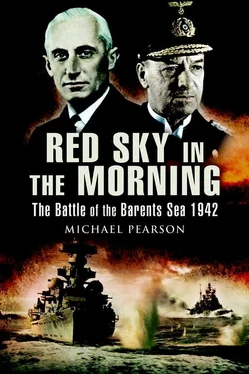At the Geneva conference of 1927, a further attempt to limit the potentially damaging naval arms race between the major powers disbanded without agreement, primarily due to Britain’s inability to accept restrictions on cruiser strength again proposed by the United States. January 1930 saw a third conference, this time in London, at which Britain finally allowed itself to be persuaded by the United States to accept a reduction in cruiser strength from seventy units to fifty, with a maximum new build programme of no more than 91,000 tons by December 1936. This reluctant agreement was in no small part brought about by the dire economic circumstances in which Britain and most of the industrialised nations of the world found themselves during the 1930s, nevertheless it was to have serious consequences for the outbreak of war in 1939, by which time the Royal Navy would have only sixty-two cruisers to carry out world wide-trade protection and fleet commitments. [183]
—♦—
The Southampton class cruisers, (later known as Town class), were designed and built to counter the new cruisers of the Japanese navy, and much thought and debate went into the pros and cons of the 6 in (150 mm) gun against the larger 8 in (200 mm) option. The weight of the 6 in shell was, at 100 lb (45.3 kg), less than half that of the 8 in which tipped the scales at 250 lb (113.4 kg). To balance this, twelve 6 in could be mounted against eight 8 in, and a more rapid rate of fire achieved with the smaller gun, giving the 6 in cruiser a superiority in weight of broadside of nearly three to one – 7200 lb (3266 kg) per minute, against the 2500 lb (1481 kg) of its bigger-gunned rival. [184]Despite these advantages the smaller gun could be outranged, requiring the 6 in cruiser to close the enemy as rapidly as possible while having improved armour protection to withstand hits while it manoeuvred into a firing position. Inevitably, higher speed and heavier armour are impossible to equate on a restricted budget, therefore the Southamptons were provided with heavier armour and their speed held at 32 knots. [185]An engagement at night or in poor visibility (dependent upon the efficiency or otherwise of the protagonists’ radar equipment) was expected to favour the smaller-gunned ship. The Battle of the Barents Sea falls nicely into this scenario, as Sheffield and Jamaica were able to close on the larger-gunned Admiral Hipper and open fire from comparatively short range.
Sheffield had the distinction of being only the second Royal Navy warship to be equipped with the fledgling radar (or ‘radio location’ as it was initially known), being fitted with the Type 79 RDF in November 1938. The first vessel so equipped was the battleship Rodney in August of that year.
—♦—
Sheffield had a busy war, and a career which amply illustrates the dual cruiser roles of keeping open Britain’s supply routes, plus fleet duties. On 7 April 1940 she accompanied a Home Fleet battle group sent north for the abortive Norwegian campaign, and later that year was transferred to Admiral Sir James Somerville’s Force ‘H’ stationed at Gibraltar. Here she took part in a complicated series of operations designated Hats , Coat and Collar , which aimed at reinforcing Admiral Cunningham’s fleet in the eastern Mediterranean, while passing merchant ships through to supply Malta. As already noted (see Appendix I), Sheffield accompanied the Excess convoy on the western Mediterranean leg of its trip from Gibraltar to Malta and Greece in early January 1941.
In May 1941 Bismarck broke out into the Atlantic, and Force ‘H’, including the carrier Ark Royal , was ordered north from Gibraltar to strengthen the escort of a convoy of five troopships bound for the Middle East. Subsequently brought directly into the hunt, Admiral Somerville detached Sheffield to shadow Bismarck , and ordered Ark Royal to prepare and launch an air strike. Unfortunately the Fleet Air Arm pilots were not notified that Sheffield would be in the same area as their target, and attacked the British cruiser. Luckily for Sheffield the aircraft used torpedoes fitted with new magnetic detonators, which proved faulty. Of the eleven torpedoes launched, six exploded on impact with the water, and the cruiser managed to dodge the remainder. Ironically this potentially catastrophic case of mistaken identity may have been a blessing in disguise. The torpedo detonators were changed to the old contact type for Ark Royal ’s next attack, which damaged Bismarck enough for a Home Fleet battle group to catch and sink her.
September 1941 saw Sheffield and Force ‘H’ participating in Operation Halberd , designed to escort another convoy through to Malta. This was carried out successfully, but the convoy suffered numerous air attacks en route , and a torpedo hit damaged the escort flagship, the battleship Nelson . The following month the cruiser returned to home waters for a brief spell before being transferred to Arctic convoy duty. On 4 March 1942 she hit a mine and was out of action until July. On completion of repairs convoy duty resumed, with the exception of a brief spell in December when she flew the flag of Rear-Admiral C.H.J. Harcourt, while supporting the Torch landings in North Africa.
Following the Battle of the Barents Sea she continued Arctic escort duties until February 1943, transferring to operations in the Bay of Biscay until August, and thereafter supporting the Salerno landings in the Mediterranean. By December Sheffield was back in the Arctic, and took part in the sinking of the Scharnhorst . In 1944 the cruiser supported raids against Tirpitz before being scheduled for a well-earned refit in Boston, Massachusetts. She returned to the UK for completion of the work, and was still under refit when the war ended.
This fine ship remained in service with the Royal Navy until September 1964, finally being disposed of for breaking up in 1967.
—♦—
In 1937 a second London Naval Treaty restricted cruisers to a maximum displacement of 8000 tons, which, for the Royal Navy meant that construction of the Southampton class could not be continued. A new design conforming to the smaller tonnage restriction was required, and the result was the Fiji class. Various sizes and configurations of main armament were considered, but finally twelve 6 in (150 mm) was adopted, as with the Southamptons.
HMS Jamaica spent most of her wartime career on Arctic convoy duty, participating in the Battle of the Barents Sea in December 1942, and the sinking of the Scharnhorst in December 1943. Prior to those actions, in company with Sheffield she supported the Torch landings in North Africa. In 1944 she interspersed convoy escort duties with supporting carrier operations against the Norwegian coast. After the war the cruiser spent time on both the East and West Indies stations, and was part of the 5th Cruiser Squadron in the Far East for the Korean War. Finally paid off, she arrived at Dalmuir on 20 December 1960 for scrapping. [186]
—♦—
After much discussion the Royal Navy finally accepted the necessity for two distinct types of destroyer, a larger, faster, more heavily armed type for fleet actions, and a smaller type for convoy escort, with the accent on anti-submarine and anti-aircraft armament. It was hoped that this would help to alleviate a chronic shortage in gun production and fire control equipment, which lagged behind the rate at which construction of destroyer hulls was possible. [187]The ‘O’ class were the first of the new escort destroyers, and to illustrate the dire shortage of guns, with the exception of Onslow , were equipped with 4 in (100 mm) main armament, some of which dated back to the First World War.
Читать дальше












